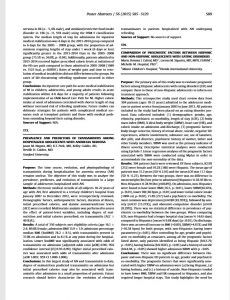Comparison of prognostic factors between Hispanic and non-Hispanic adolescents with eating disorders
 Abstract/Purpose: The primary aim of this study was to evaluate prognostic factors among Hispanic adolescents with eating disorders (ED) and compare them to those of non-Hispanic adolescents to inform our treatment approach.
Abstract/Purpose: The primary aim of this study was to evaluate prognostic factors among Hispanic adolescents with eating disorders (ED) and compare them to those of non-Hispanic adolescents to inform our treatment approach.
Methods: This retrospective study used chart review data from 304 patients (ages 10-21 years) admitted to the adolescent medicine in-patient service from January 2003 to June 2013. All patients included in the study had been placed on an eating disorder protocol. Data collected included: (1) demographics: gender, age, ethnicity, psychiatric co-morbidity, length of stay (LOS), (2) body mass index (BMI), % ideal body weight (%IBW), heart rate (HR), and caloric intake on admission and discharge, (3) prognostic factors: body image concerns, history of sexual abuse, suicide, negative life experiences, athletic involvement, substance use, use of laxatives, diet pills, and diuretics, psychiatric history of mother, father and other family members. %IBW was used as the primary indicator of illness severity. Descriptive statistical analyses were conducted using Epi Info 7. Linear regression analyses of the prognostic factors associated with %IBW were conducted using Mplus in order to accommodate the non-normality of the data.
Results: 304 patient charts were reviewed. Of these subjects, 82.9% (252) were female and 59.2% (180) were Hispanic. The mean age of patients was 15.2 years (SD ¼ 2.16) and the mean LOS was 11.7 days (SD ¼ 11.23). Between the two groups, there was no difference in mean weight (lbs) lost prior to admission [Hispanics ¼ 28.56 lbs vs. Non-Hispanics ¼ 28.94 lbs (p¼0.89)]. On admission, non-Hispanics were found to have lower BMI (16.5, p<0.01), lower %IBW(82.65%, p<0.01), lower HR (46 bpm, p<0.01) and lower initial caloric intake (1400 cal, p<0.02). 71.4% (217) had a psychiatric co-morbidity. The most common was depression [n¼180 (82.95%)], followed by anxiety [n¼33 (15.21%)], and obsessive-compulsive disorder [n¼18 (8.29%)]. There was no statistical difference in prevalence of psychiatric co-morbidity between the two groups. When comparing LOS, non-Hispanics had a longer hospital stay (mean ¼ 14.65 days) compared to Hispanics (mean ¼ 9.68 days) (p<0.01). On discharge, there was an overall increase in BMI (+0.89), %IBW(+4.67%) and HR (+10.38 bpm) for both groups, with non-Hispanics having lower parameters (p<0.05). After controlling for age, gender and psychiatric co-morbidity as covariates, among all the prognostic factors listed above, only patients identified as being Hispanic (b¼3.79, p <0.05), having bulimia (b¼10.83, p <0.05) and a history of suicide (b¼4.94, p <0.05) showed higher admission %IBW with p <0.05.
Conclusions: There was no significant difference between Hispanic and non-Hispanic ED patients in age, gender and psychiatric co-morbidity. The prognostic factors that were significantly associated with higher %IBW on admission were (a) being Hispanic, (a) having bulimia, and (c) a history of suicide. Non-Hispanics tended to have lower BMI, %IBW and HR compared to Hispanics, and also required longer hospital stays. This study highlights the need for Poster Abstracts / 56 (2015) S85eS129 S89 further exploration of why Hispanic adolescents with eating disorders are presenting earlier (higher BMI) than non-Hispanics.
Cabral, M.D., Siqueira, L.M., & Hospital, M.M. (2015). 174. Comparison of prognostic factors between Hispanic and non-Hispanic adolescents with eating disorders. Journal of Adolescent Health, 56(2). doi:10.1016/j.jadohealth.2014.10.179
